MH REITs Report is a Quarterly Overview of Manufactured Housing Industry Real Estate Investment Trusts
The research team at Hoya Capital Real Estate is excited to continue our quarterly column published in partnership with MHInsider to provide insight and commentary on publicly-traded manufactured housing stocks. Every quarter, we’ll publish an update to discuss the stock performance, earnings results, and major news and events reported by manufactured housing real estate investment trusts, or MH REITs.
Overview of MH REITs

There are three U.S. exchange-listed Manufactured Housing REITs which collectively account for roughly $35 billion in market value: Equity Lifestyle (ELS), Sun Communities (SUI), UMH Properties (UMH). Additionally, newly-listed Flagship Communities (FLGMP) trades on the Toronto Stock exchange.
Manufactured Housing REITs collectively own roughly 350,000 manufactured housing and RV sites across the United States with a portfolio skewed toward higher-end communities with a more “retiree-oriented” demographic than the all-ages community.
Through a series of acquisitions, Equity Lifestyle and Sun Communities have recently expanded into boat marinas as well while the smaller UMH Properties and newly-listed Flagship Communities focus on traditional manufactured housing communities.

Manufactured housing REITs have emerged over the past decade from relative obscurity into several of the largest publicly-traded owners of real estate in the world. Beneficiaries of the lingering housing shortage across the United States resulting from a decade of underbuilding, manufactured housing REITs have been the single-best performing REIT sector since the start of 2010, delivering an incredible 22% annual compound total returns from 2010 through 2020.
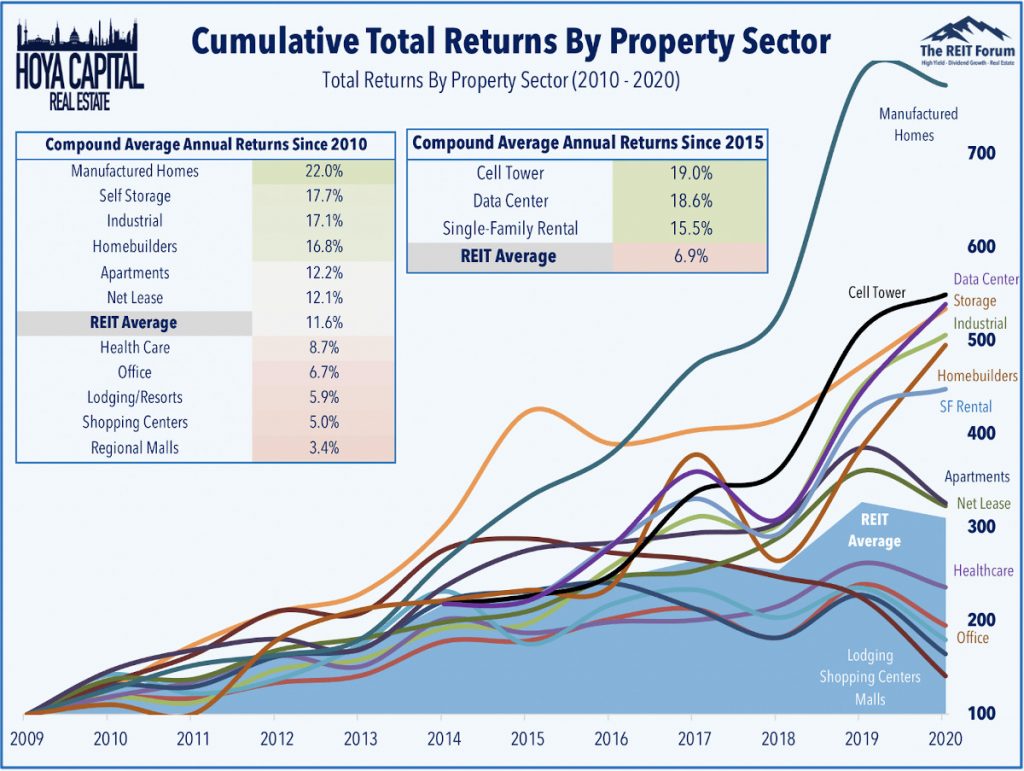
Manufactured housing REITs outperformed the broad-based Equity REIT Index for a remarkable eighth-straight year in 2020, the longest streak of outperformance for any property sector since the dawn of the “Modern REIT Era” in the early 1990s.
From an investment perspective, despite their high growth rates, MH REITs are a traditionally defensive and countercyclical sector due to the “sticky” nature of MH demand and cash flows. While these REITs are not known for their high dividend yields, these REITs have delivered some of the strongest rates of dividend growth of any REIT sector.
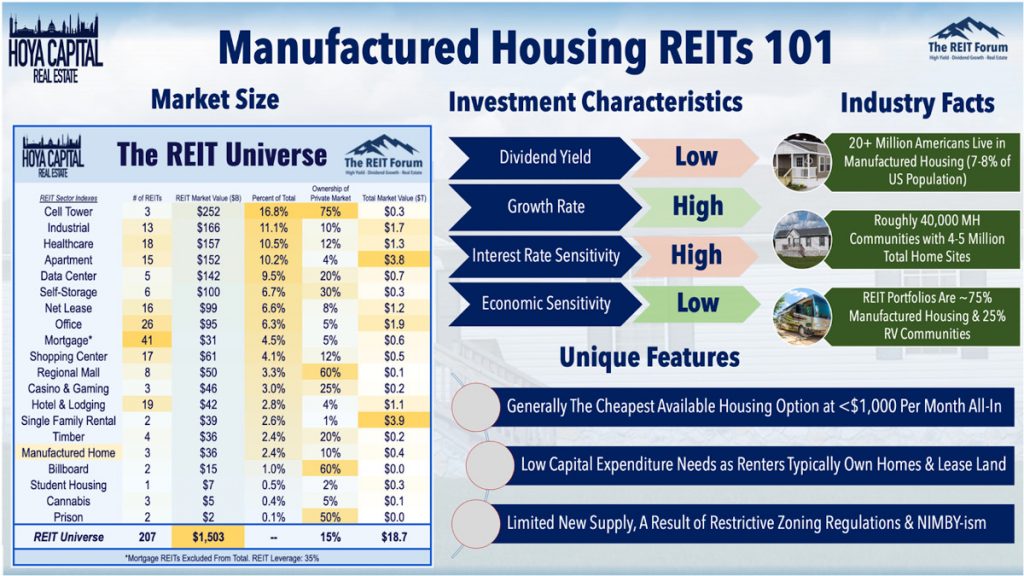
Second Quarter 2021 MH REITs Performance
MH REITs were under pressure earlier this year by the ‘REIT Reopening Rotation,’ but this underperformance didn’t last long as MH REITs have been one of the best-performing sectors since the start of the second quarter. MH REITs are now higher by 21.8% this year, slightly lagging the 23.7% gains from the broad-based Vanguard Real Estate ETF (VNQ), but beating the 16.5% returns from the S&P 500 (SPY).
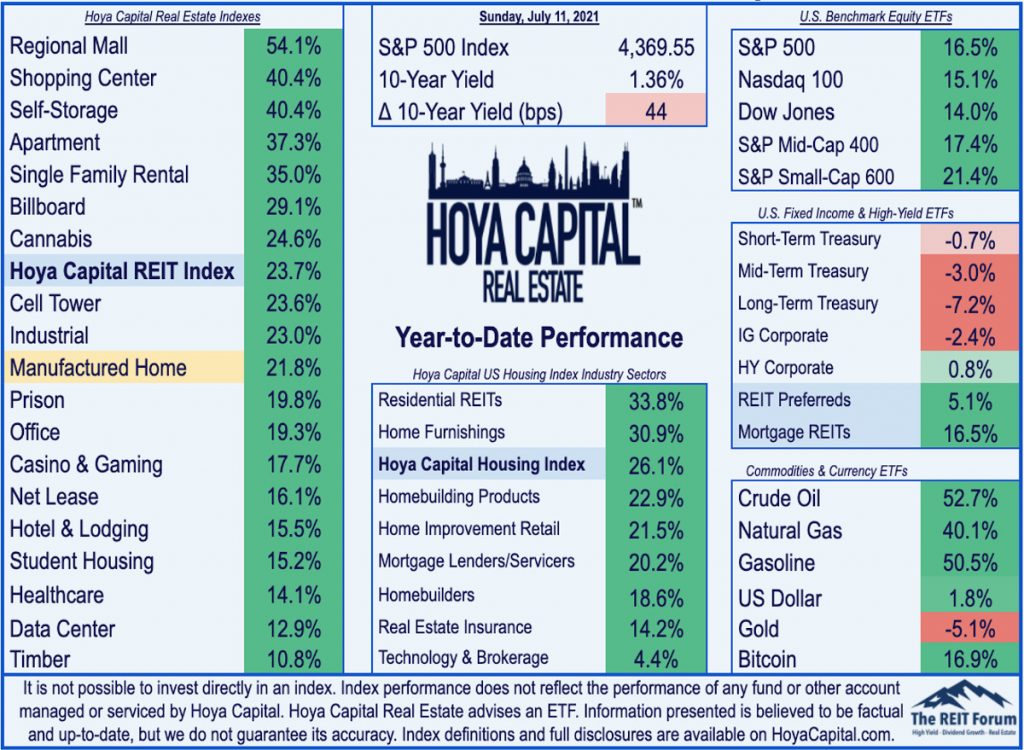
Consistent with the trends across the residential REIT industry over the past quarter, MH REITs significantly boosted their growth outlook over the last quarter, citing strong rental housing demand and substantial upward rent pressure. Same-store Net Operating Income (“NOI”) growth continues to accelerate following a brief pandemic-related slowdown as property-level growth is now expected to rise by nearly 7% for full-year 2021.
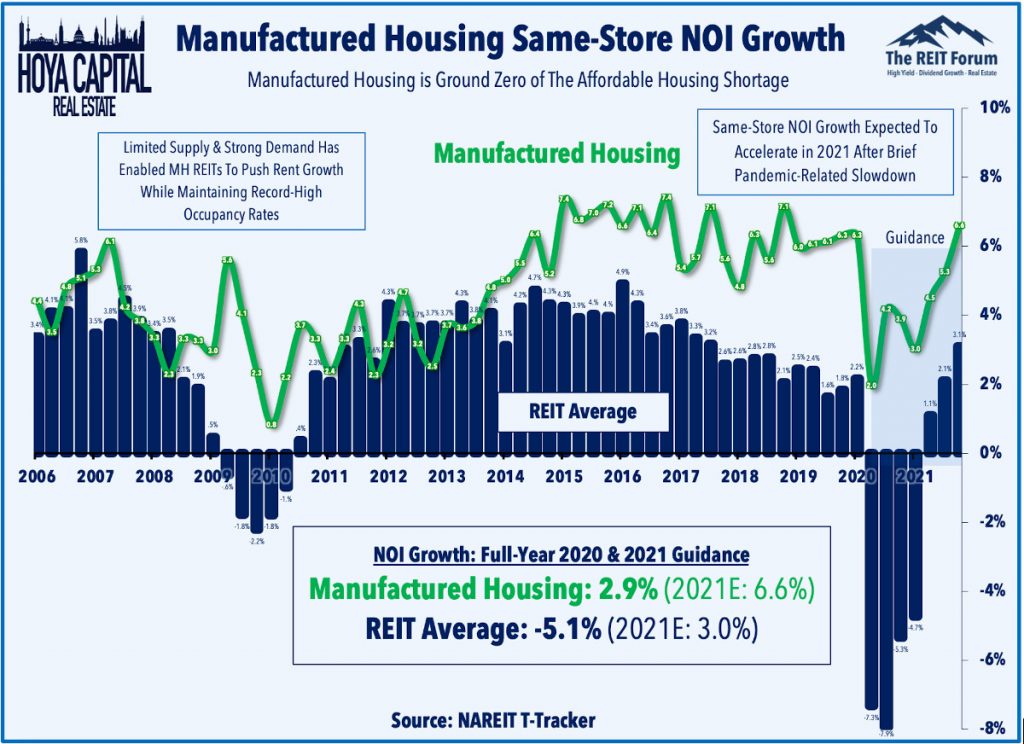
Growth in funds from operations – the earnings per share “equivalent” for REITs – is driven by the combination of same-store “organic” growth and by external growth through acquisitions and new development. Forward guidance over the past quarter was particularly impressive as ELS and SUI project growth in Funds From Operations (“FFO”) of nearly 14% this year – which would surely be one of the strongest growth rates in the REIT sector.
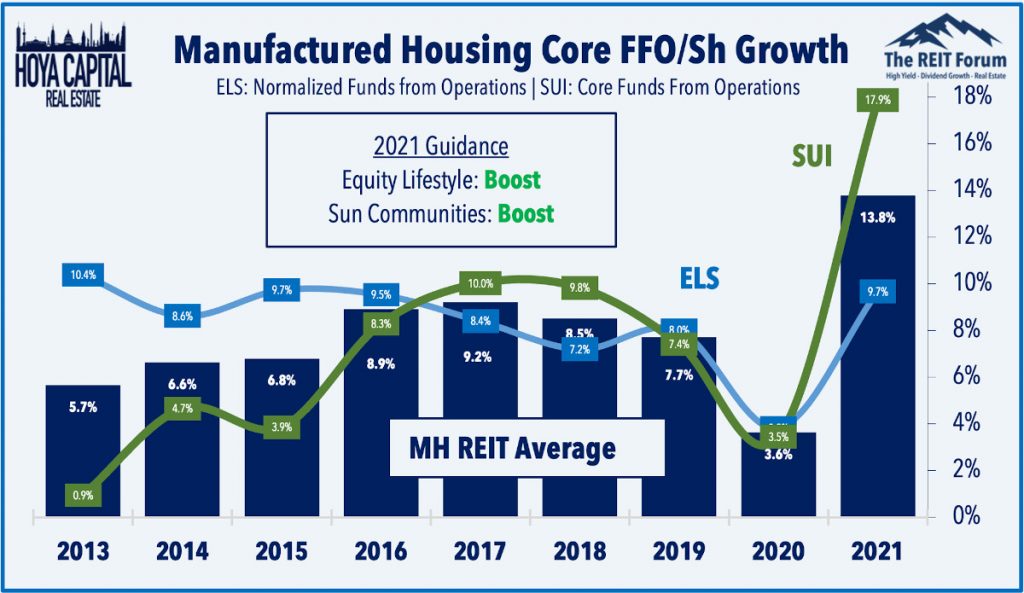
Utilizing a strong cost of equity capital, these REITs have continued to grow externally by adding units to existing sites and by growing via acquisitions and site expansions. MH REITs acquired more than $1.5 billion worth of properties over the last year, largely in one-off acquisitions while disposing of just $10 million in assets. The most significant deal in 2020 was Sun Communities’ $2.1B purchase of Safe Harbor Marinas, which owns and operates 101 institutional-quality boat marinas.
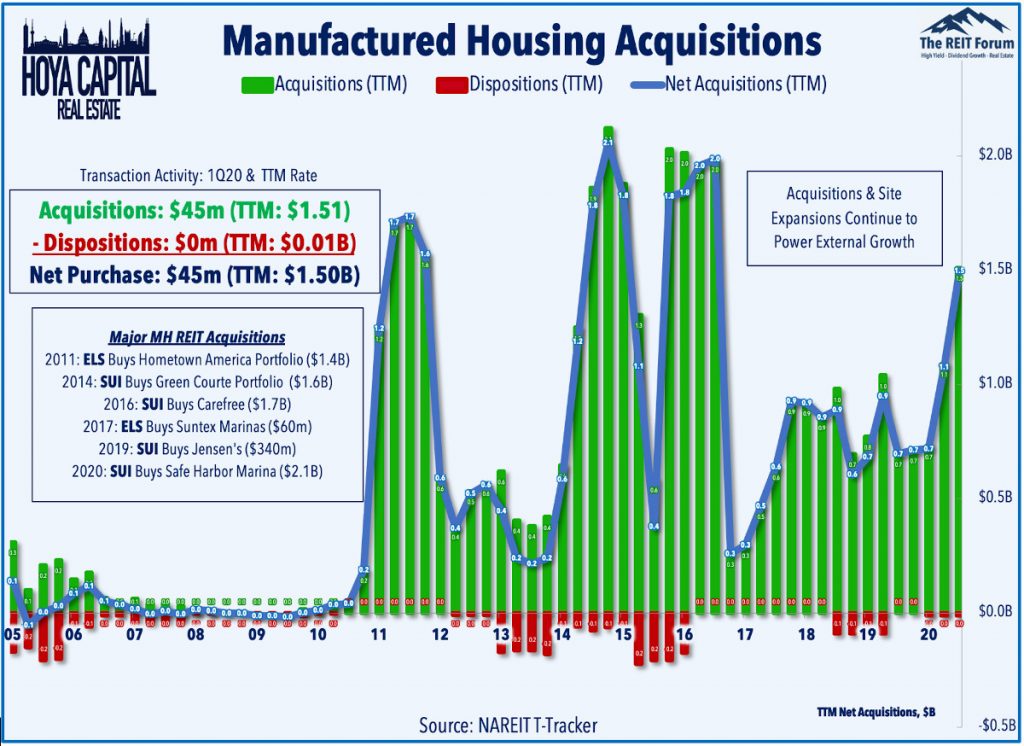
Manufactured Housing Industry Data Points
MH REITs’ amplified focus on analogous asset classes – RV parks and marinas – was perfectly-timed, providing an added external growth tailwind. “Work-From-Anywhere” has fueled soaring RV, boat, and vacation home sales. The RV Industry Association expects RV wholesale shipments to climb to their highest historical total ever. While the RV industry has faced similar supply chain issues as traditional homebuilders, the RVIA sees shipments rising to 576k units in 2021, which would be a 14.1% gain over the current comparable record high of 504,600 units in 2017.

The National Marine Manufacturers Association, meanwhile, reported that powerboat sales are also poised to set record-highs this year despite inventory levels that are “the leanest they’ve ever been.” With SUI’s major investment in Safe Harbor Marinas, these MH REITs are now the two largest owners of marinas in the United States, an asset class with nearly identical fundamental characteristics as their large portfolio of RV parks. Marinas offer substantial operating parallels to the company’s RV business and that there are roughly 4,500 marinas in the US, of which 500 would be considered “institutional quality.” Earlier this year, ELS also expanded its marina portfolio with a purchase of 11 marinas, containing 3,986 slips, for $262.0 million.
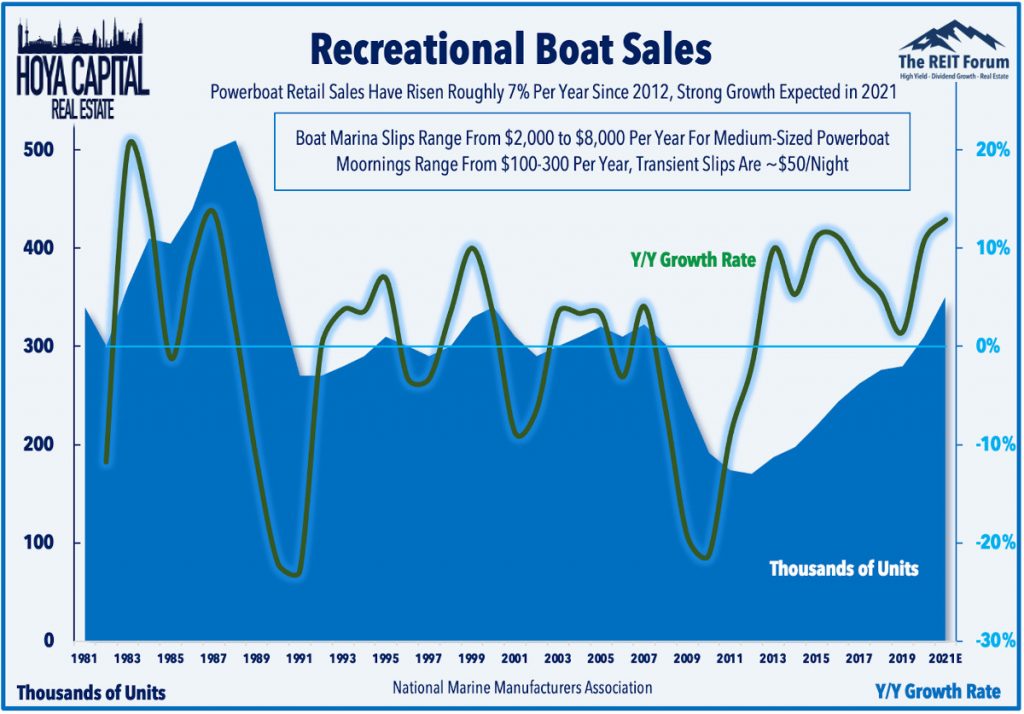
MH REITs Key Takeaways
Low supply and strong demand have driven stellar fundamental performance for MH REITs over the past half-decade, and the MH sector continues to deliver sector-leading NOI and FFO growth. Consistent with the trends across the residential REIT sectors over the past quarter MH REITs significantly raised their growth outlook, citing strong rental housing demand and substantial upward rent pressure. While MH REIT valuation are now back towards the top-end of their historical range following double-digit returns over the last quarter, don’t bet against MH REITs, the perennial outperformers of the real estate sector and key beneficiaries of the persistent housing shortage across the United States.
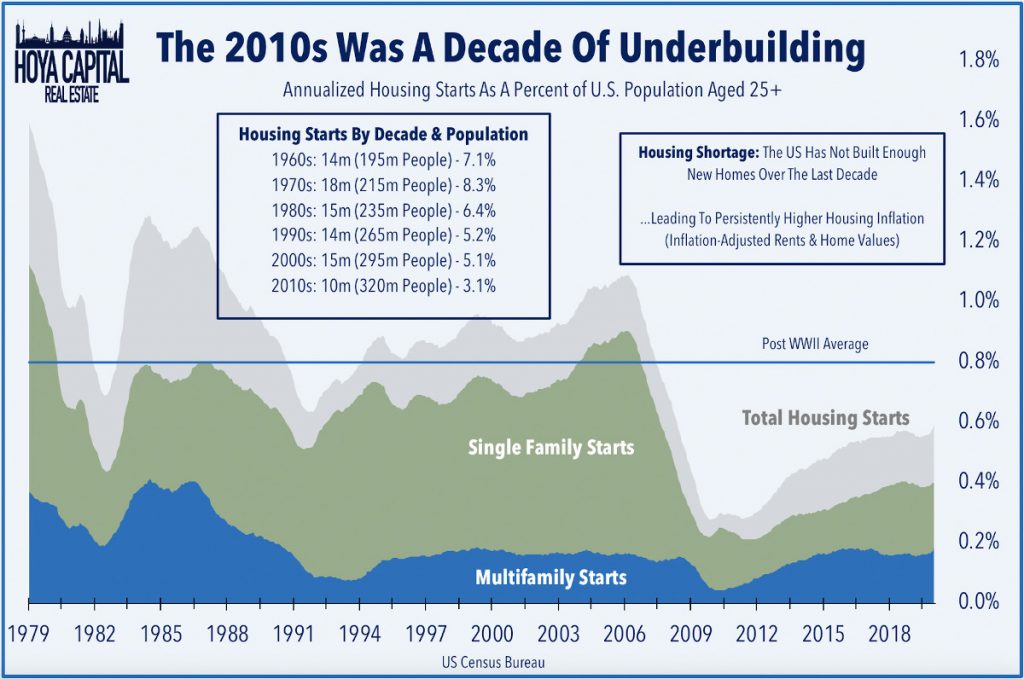
MH REITs REPORT Terms Defined
FFO (Funds From Operations): The most commonly accepted and reported measure of REIT operating performance. Equal to a REIT’s net income, excluding gains or losses from sales of property and adding back real estate depreciation.
AFFO (Adjusted Funds From Operations): A non-standardized measurement of recurring/normalized FFO after deducting capital improvement funding and adjusting for “straight line” rents.
NOI (Net Operating Income): Typically reported on a “same-store” comparable basis, NOI is a calculation used to analyze the property-level profitability of real estate portfolios. NOI equals all revenue from the property, minus all reasonably necessary operating expenses.
Hoya Capital Disclosures
I am/we are long ELS and SUI. I am not receiving compensation for it. It is not possible to invest directly in an index. Index performance cited in this commentary does not reflect the performance of any fund or other account managed or serviced by Hoya Capital Real Estate. Nothing on this site nor any published commentary by Hoya Capital is intended to be investment, tax, or legal advice or an offer to buy or sell securities. Information presented is believed to be factual and up-to-date, but we do not guarantee its accuracy and should not be considered a complete discussion of all factors and risks. A complete discussion of important disclosures is available on our website www.HoyaCapital.com.










